Key Takeaways
| Aspect | Details |
| Kei Car Definition | Small, lightweight vehicles popular in Japan for their efficiency and compact size. |
| Cultural Impact | Integral part of Japanese automotive culture, symbolizing innovation and adaptability. |
| Top Models | A curated list of the top 10 kei cars, showcasing their unique features and historical significance. |
Japanese Kei cars, known for their compact size and efficiency, have etched an indelible mark in the automotive world. These small, lightweight vehicles are more than just a means of transportation; they represent a distinct segment of Japanese culture, combining practicality with innovation. In this article, we delve into the “Top 10 Japanese Kei Cars,” showcasing models that not only have made a significant impact in Japan but also have garnered international interest.
The Fascinating World of Kei Cars: A Brief Overview
Kei cars, or “keijidōsha” in Japanese, emerged as a response to Japan’s urban and economic landscape. With limited space and a focus on efficiency, these vehicles became the go-to option for many. Their appeal lies not just in their size, but also in their cost-effectiveness, lower tax and insurance rates, and their quirky, often innovative designs.
Top 10 Japanese Kei Cars: A Countdown
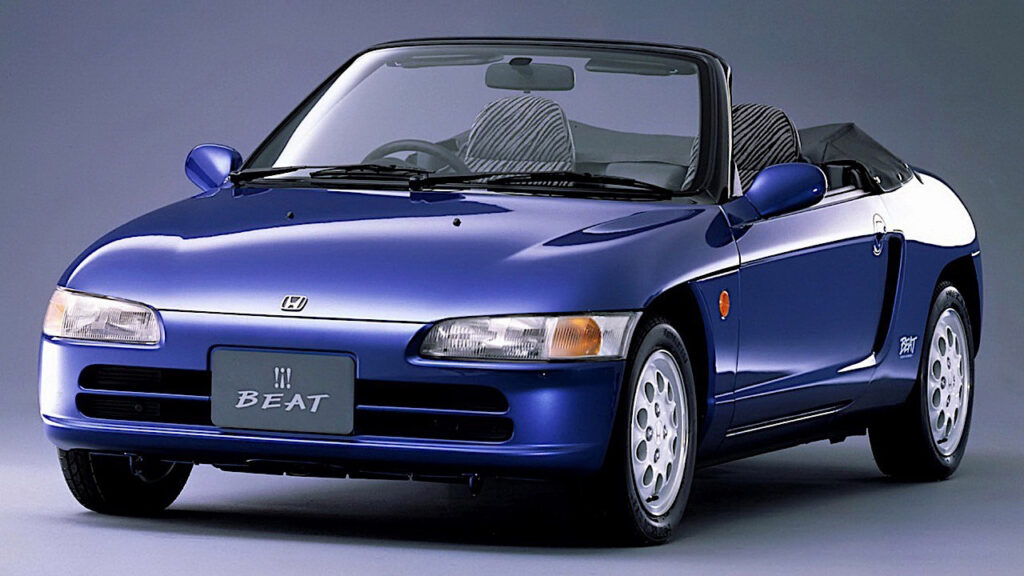
1. Honda Beat: A Kei Car Icon
The Honda Beat stands out as a true icon in the realm of Japanese Kei cars. Introduced in 1991, it was one of the last projects approved by Soichiro Honda, the founder of Honda, making it a significant model in the company’s history. This mid-engine, rear-wheel-drive roadster is renowned for its agile handling and spirited driving experience, embodying the essence of a sports car within the constraints of Kei car dimensions.
Design and Performance
The Beat’s design is a blend of style and functionality. Its compact dimensions did not hinder its aesthetic appeal; instead, they contributed to a distinct, sporty look. The car featured a zippy 656 cc engine, which, while adhering to Kei car regulations, delivered an engaging driving experience. The mid-engine layout provided excellent balance and handling, making it a favorite among driving enthusiasts.
Cultural Impact
Beyond its technical attributes, the Honda Beat has a special place in Japanese automotive culture. It represents the innovative spirit of Japan’s auto industry during the early 90s, a period marked by economic challenges and technological advancements. The Beat is not just a car; it’s a symbol of overcoming constraints with creativity and engineering prowess.
The Beat’s Legacy
Today, the Honda Beat is a sought-after classic, cherished by collectors and admired by car enthusiasts worldwide. Its rarity and historical significance have only added to its allure, making it a timeless piece of automotive history.
Honda Beat Statistics
| Specification | Detail |
| Production Years | 1991-1996 |
| Engine | 656 cc E07A MTREC I3 |
| Power | 63 hp (47 kW) |
| Transmission | 5-speed manual |
| Drive Type | Mid-engine, rear-wheel drive |
| Dimensions (LxWxH) | 3,295 mm x 1,395 mm x 1,175 mm |
| Curb Weight | Approximately 760 kg |
| Unique Features | Gull-wing doors, convertible top, MTREC (Multi Throttle Responsive Engine Control) system |
The Honda Beat remains a testament to the unique charm and engineering ingenuity of Japanese Kei cars. Its legacy continues to inspire automotive enthusiasts and serves as a reminder of the endless possibilities within the world of compact vehicles.
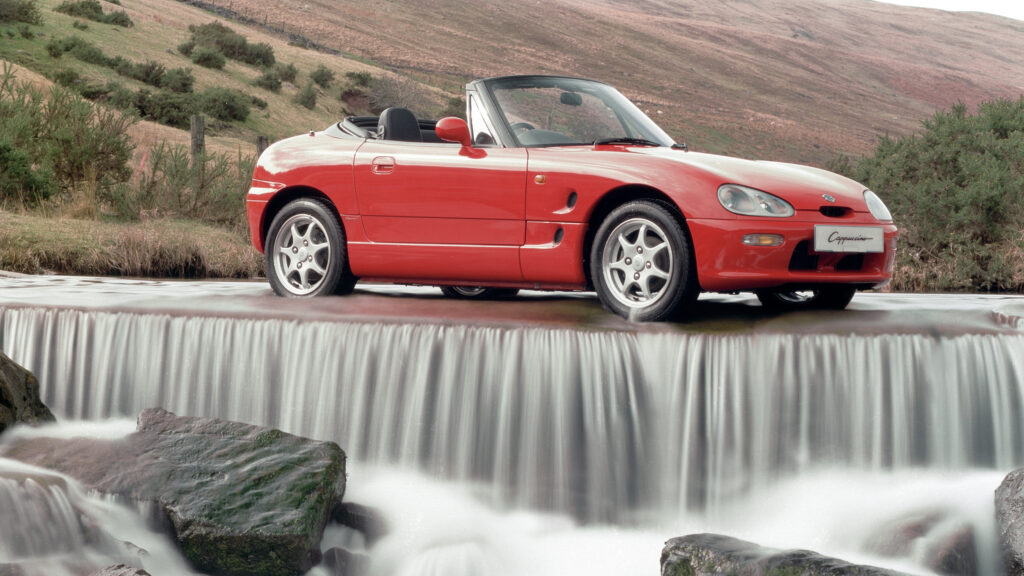
2. Suzuki Cappuccino: A Compact Sports Car Marvel
The Suzuki Cappuccino is a revered name in the realm of Kei cars, known for bringing the sports car experience into the compact dimensions of Japan’s unique automotive class. Launched in 1991, this tiny titan has since captured the hearts of car enthusiasts around the globe with its combination of style, performance, and versatility.
Innovative Design
What sets the Cappuccino apart is its cleverly engineered convertible top, allowing drivers to experience it as a closed coupe, a T-top, or a full convertible. This versatility, combined with its lightweight construction, makes the Cappuccino an absolute joy to drive. The car’s design is not only functional but also aesthetically pleasing, sporting a classic sports car silhouette that defies its small size.
Performance and Handling
At the heart of the Suzuki Cappuccino is a turbocharged 657 cc engine, which provides an exciting driving experience without compromising on efficiency. The front-engine, rear-wheel-drive layout contributes to its balanced handling and responsive steering, making it a favourite for spirited driving and even amateur racing.
Cultural Significance
The Cappuccino is more than just a vehicle; it’s a symbol of Suzuki’s innovation in the Kei car segment. It showcases how Japanese automakers have been able to create cars that are not only practical for urban environments but also fun and engaging to drive.
Suzuki Cappuccino Statistics
| Specification | Detail |
| Production Years | 1991-1997 |
| Engine | 657 cc turbocharged I3 |
| Power | 63 hp (47 kW) |
| Transmission | 5-speed manual / 3-speed automatic |
| Drive Type | Front-engine, rear-wheel drive |
| Dimensions (LxWxH) | 3,295 mm x 1,395 mm x 1,175 mm |
| Curb Weight | Approximately 725 kg |
| Unique Features | Convertible top with multiple configurations, sleek design |
The Suzuki Cappuccino remains a standout example of the ingenuity and charm of Kei cars. It continues to be celebrated by car enthusiasts for its unique blend of compact efficiency and sports car excitement.

3. Daihatsu Hijet: A Versatile Kei Workhorse
The Daihatsu Hijet holds a unique position in the Kei car world, known for its versatility and enduring popularity in both personal and commercial applications. Since its introduction in 1960, the Hijet has been a mainstay in Japan, evolving over the years to meet varying needs while maintaining its compact, efficient essence.
Adaptable Design
The Hijet’s design is primarily focused on maximizing utility within the Kei car size constraints. Available in various configurations, including vans and trucks, it caters to a wide range of needs, from personal city driving to commercial deliveries. Its boxy shape and clever use of space make it incredibly functional, offering more interior room and cargo space than one might expect from its exterior dimensions.
Performance and Reliability
Under the hood, the Hijet typically features a small, efficient engine that provides enough power for city driving and light transport needs. Its reliability is one of its strongest selling points, with many older models still in use today, a testament to Daihatsu’s engineering and build quality.
Cultural and Economic Impact
The Hijet is not just a vehicle; it’s a part of Japan’s economic fabric. It has been instrumental in supporting small businesses and entrepreneurs, symbolizing the hardworking nature of Japan’s economy. Its enduring presence on the roads is a reflection of its practicality and the trust it has earned over decades.
Daihatsu Hijet Statistics
| Specification | Detail |
| Production Years | 1960-Present |
| Engine | Varies by model, typically small-displacement I3 or I4 |
| Power | Varies, in line with Kei car regulations |
| Transmission | Manual / Automatic options |
| Drive Type | Front-engine, rear-wheel drive / four-wheel drive |
| Dimensions (LxWxH) | Varies by model, within Kei car size limits |
| Curb Weight | Varies, typically around 700-900 kg |
| Unique Features | Wide variety of body styles, including van and truck configurations |
The Daihatsu Hijet’s longevity and versatility make it a standout in the Kei car segment. It demonstrates the practicality and adaptability of small vehicles, making it a beloved choice for many in Japan and beyond.

4. Mitsubishi Minica: A Reflection of Evolution in Kei Cars
The Mitsubishi Minica is a significant player in the history of Japanese Kei cars. Spanning nearly five decades of production, from 1962 to 2011, the Minica is a prime example of the evolution and adaptability of Kei cars over time. It has undergone several transformations, mirroring the changes in technology, design trends, and consumer needs.
Design Evolution
The Minica’s design evolution is a journey through the changing aesthetics and technological advancements in the automotive industry. From its initial iteration as a simple, functional city car to its later models incorporating more modern design elements, the Minica always stayed true to the core principles of a Kei car: compact size, efficiency, and practicality.
Performance and Versatility
Throughout its various generations, the Minica featured small, efficient engines in line with Kei car regulations, providing sufficient power for urban driving. Its compact size made it ideal for navigating narrow streets, while its clever interior layout maximized space for passengers and cargo within a small footprint.
Cultural and Historical Significance
The Mitsubishi Minica is more than just a car; it’s a chronicle of Japan’s automotive history. Each model reflects the technological and economic landscape of its time, making the Minica a fascinating study in automotive design and cultural trends.
Mitsubishi Minica Statistics
| Specification | Detail |
| Production Years | 1962-2011 |
| Engine | Varies by generation, typically small-displacement I3 |
| Power | In line with Kei car regulations |
| Transmission | Manual / Automatic options |
| Drive Type | Front-engine, front-wheel drive / four-wheel drive |
| Dimensions (LxWxH) | Varies by generation, within Kei car size limits |
| Curb Weight | Varies, typically around 600-800 kg |
| Unique Features | Evolving design reflecting different eras, practical and versatile |
The Mitsubishi Minica’s long production run and its ability to adapt to changing times make it a notable example of the enduring appeal and versatility of Kei cars.
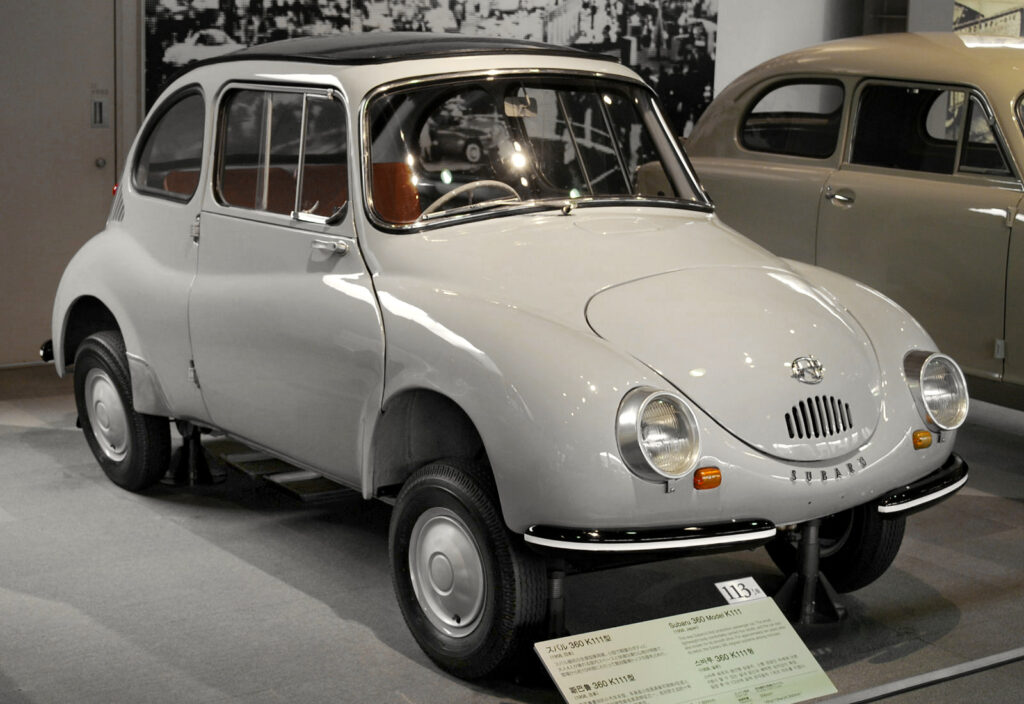
5. Subaru 360: An Icon of Post-War Japan
The Subaru 360 holds a special place in the history of Japanese Kei cars and is often regarded as an icon of Japan’s post-war automotive resurgence. Introduced in 1958, this charming and distinctive car captured the hearts of many with its unique design and became known affectionately as the “ladybug” in Japan.
Design and Innovation
The design of the Subaru 360 was revolutionary for its time. Its rounded, bug-like shape not only gave it a distinctive look but also maximized interior space within the small exterior dimensions mandated by Kei car regulations. The use of a lightweight monocoque body and a rear-mounted engine was innovative, contributing to the car’s agility and fuel efficiency.
Cultural Significance
The Subaru 360 played a crucial role in mobilizing post-war Japan. It offered affordable transportation to the masses at a time when Japan was rebuilding its economy. The 360 symbolized hope and progress, becoming an integral part of Japan’s journey towards modernization and economic growth.
Enduring Legacy
Today, the Subaru 360 is celebrated as a classic, embodying the charm and ingenuity of early Japanese Kei cars. Its significance goes beyond its technical aspects; it’s a cultural artefact that tells a story of resilience and innovation.
Subaru 360 Statistics
| Specification | Detail |
| Production Years | 1958-1971 |
| Engine | 356 cc 2-stroke I2 |
| Power | 25 hp (19 kW) |
| Transmission | 4-speed manual |
| Drive Type | Rear-engine, rear-wheel drive |
| Dimensions (LxWxH) | 2,990 mm x 1,300 mm x 1,380 mm |
| Curb Weight | Approximately 385 kg |
| Unique Features | Distinctive “ladybug” design, lightweight monocoque body |
The Subaru 360’s enduring appeal lies in its historical significance and the simplicity of its design, making it a beloved classic in the world of Kei cars and beyond.

6. Autozam AZ-1: A Rare Gem in the Kei Car World
The Autozam AZ-1 stands out as a unique and rare specimen in the world of Japanese Kei cars. Produced by Mazda under the Autozam brand from 1992 to 1994, this diminutive sports car is renowned for its bold design, including its distinctive gull-wing doors, a rarity in the Kei car segment.
A Design Ahead of Its Time
The AZ-1’s design is characterized by its futuristic aesthetics, a significant departure from the conventional Kei car design. The gull-wing doors were not just a stylistic choice but also a practical solution to the car’s compact dimensions, allowing for easier access in tight parking spaces. Its mid-engine layout contributed to its balanced handling and sporty driving dynamics.
Performance and Driving Experience
Powered by a turbocharged 657 cc engine, the AZ-1 offered an exhilarating driving experience, a testament to Mazda’s engineering expertise. Despite its small size, it provided a surprisingly engaging ride, making it a favourite among driving enthusiasts who crave a unique and fun driving experience.
Rarity and Collectability
The production run of the Autozam AZ-1 was limited, making it a rare find in the automotive world. This scarcity, combined with its unique features, has made the AZ-1 a highly sought-after model among collectors and Japanese car enthusiasts.
Autozam AZ-1 Statistics
| Specification | Detail |
| Production Years | 1992-1994 |
| Engine | 657 cc turbocharged I3 |
| Power | 64 hp (48 kW) |
| Transmission | 5-speed manual |
| Drive Type | Mid-engine, rear-wheel drive |
| Dimensions (LxWxH) | 3,295 mm x 1,395 mm x 1,150 mm |
| Curb Weight | Approximately 720 kg |
| Unique Features | Futuristic design, gull-wing doors |
The Autozam AZ-1 is more than just a car; it’s a piece of automotive art, embodying the creativity and innovation that the Kei car segment is known for.

7. Daihatsu Copen: A Modern Kei Car with Style and Customizability
The Daihatsu Copen represents a modern interpretation of the Kei car concept, blending traditional compact efficiency with contemporary design and technology. Launched in 2002 and still in production, the Copen has become a popular choice for those seeking a blend of style, performance, and versatility in a small package.
Design and Customization
One of the most striking features of the Daihatsu Copen is its retractable hardtop, a rarity in the Kei car segment. This feature allows for a seamless transition from a cozy coupe to an open-top roadster, offering a versatile driving experience. The Copen also stands out for its customizable body panels, allowing owners to personalize their cars to match their style.
Performance and Driving Dynamics
Despite its compact dimensions, the Copen delivers a spirited driving experience. It’s equipped with a small, turbocharged engine that provides sufficient power and agility for city driving and occasional spirited runs. The car’s lightweight construction and well-tuned suspension contribute to its nimble handling and responsive steering.
Contemporary Appeal
The Daihatsu Copen appeals to a broad audience, from young urbanites to car enthusiasts who appreciate its blend of modern design and traditional Kei car virtues. It symbolizes the evolution of the Kei car segment, adapting to modern tastes and technological advancements while staying true to the concept of compact efficiency.
Daihatsu Copen Statistics
| Specification | Detail |
| Production Years | 2002-Present |
| Engine | 659 cc turbocharged I3 |
| Power | Varies, typically around 63 hp (47 kW) |
| Transmission | 5-speed manual / CVT automatic |
| Drive Type | Front-engine, front-wheel drive |
| Dimensions (LxWxH) | 3,395 mm x 1,475 mm x 1,275 mm |
| Curb Weight | Approximately 850 kg |
| Unique Features | Retractable hardtop, customizable body panels |
The Daihatsu Copen continues to captivate the hearts of Kei car enthusiasts, offering a unique combination of style, customization, and driving enjoyment in a compact form.

8. Suzuki Alto Works: A Pocket Rocket in the Kei Car Segment
The Suzuki Alto Works brings a touch of performance and sportiness to the Kei car category. Since its introduction in 1987, it has become a favourite among enthusiasts who crave a fun, turbocharged driving experience in a compact and efficient package.
Performance-Oriented Design
The Alto Works distinguishes itself from the standard Suzuki Alto with its enhanced performance features. It sports a turbocharged engine, sport-tuned suspension, and aesthetic upgrades like a more aggressive body kit and distinctive alloy wheels. These elements combine to offer an exciting driving experience that belies the car’s small size.
Turbocharged Power in a Compact Form
At the heart of the Suzuki Alto Works is a small, yet potent turbocharged engine that delivers surprising power and responsiveness. This, coupled with a lightweight chassis, results in a car that’s agile and fun to drive, especially in urban environments where its compact size is an advantage.
A Cult Favorite
The Alto Works has garnered a cult following among Kei car enthusiasts and those who appreciate the blend of everyday practicality with a sporty edge. It’s a vehicle that proves performance isn’t solely the domain of larger, more powerful cars.
Suzuki Alto Works Statistics
| Specification | Detail |
| Production Years | 1987-Present |
| Engine | 660 cc turbocharged I3 |
| Power | Varies, typically around 64 hp (48 kW) |
| Transmission | 5-speed manual / Automatic options |
| Drive Type | Front-engine, front-wheel drive / four-wheel drive |
| Dimensions (LxWxH) | Varies by generation, within Kei car size limits |
| Curb Weight | Approximately 700-800 kg |
| Unique Features | Turbocharged engine, sport-tuned suspension, aggressive styling |
The Suzuki Alto Works stands as a testament to the versatility and potential of the Kei car class, offering an exhilarating driving experience in a uniquely compact form.

9. Honda N-One: A Modern Take on Classic Kei Car Charm
The Honda N-One represents a modern interpretation of the Kei car ethos, blending retro styling with contemporary technology and features. Launched in 2012, the N-One has quickly become a favourite for those who appreciate its nod to classic design elements while enjoying modern conveniences and efficiency.
Retro Design with Modern Flair
The N-One’s design stands out with its retro-inspired aesthetics, paying homage to Honda’s early Kei cars like the N360. However, it’s not just about looks; the N-One incorporates modern design elements and technology, making it a fully-fledged contemporary vehicle. The result is a car that resonates with nostalgia while offering the comfort and features expected in modern automobiles.
Efficient Performance and Urban Practicality
Under the hood, the Honda N-One is powered by a small, efficient engine that’s perfectly suited for city driving. Its compact size makes it easy to navigate through tight urban spaces, and the interior is surprisingly spacious, offering a comfortable ride for passengers and practical storage solutions.
A Hit Among a Broad Audience
The N-One appeals to a wide range of drivers, from young urbanites attracted to its stylish design to older generations who appreciate the nod to Honda’s heritage. It’s also gained attention from car enthusiasts who value its blend of retro charm and modern functionality.
Honda N-One Statistics
| Specification | Detail |
| Production Years | 2012-Present |
| Engine | 660 cc I3, naturally aspirated or turbocharged options |
| Power | Varies, typically around 58 hp (43 kW) to 63 hp (47 kW) |
| Transmission | CVT automatic |
| Drive Type | Front-engine, front-wheel drive / four-wheel drive |
| Dimensions (LxWxH) | 3,395 mm x 1,475 mm x 1,615 mm |
| Curb Weight | Approximately 900-1,000 kg |
| Unique Features | Retro-inspired design, modern interior, and technology |
The Honda N-One is a delightful blend of the past and present, offering a unique package that combines the charm of classic Kei cars with the advantages of modern automotive technology.
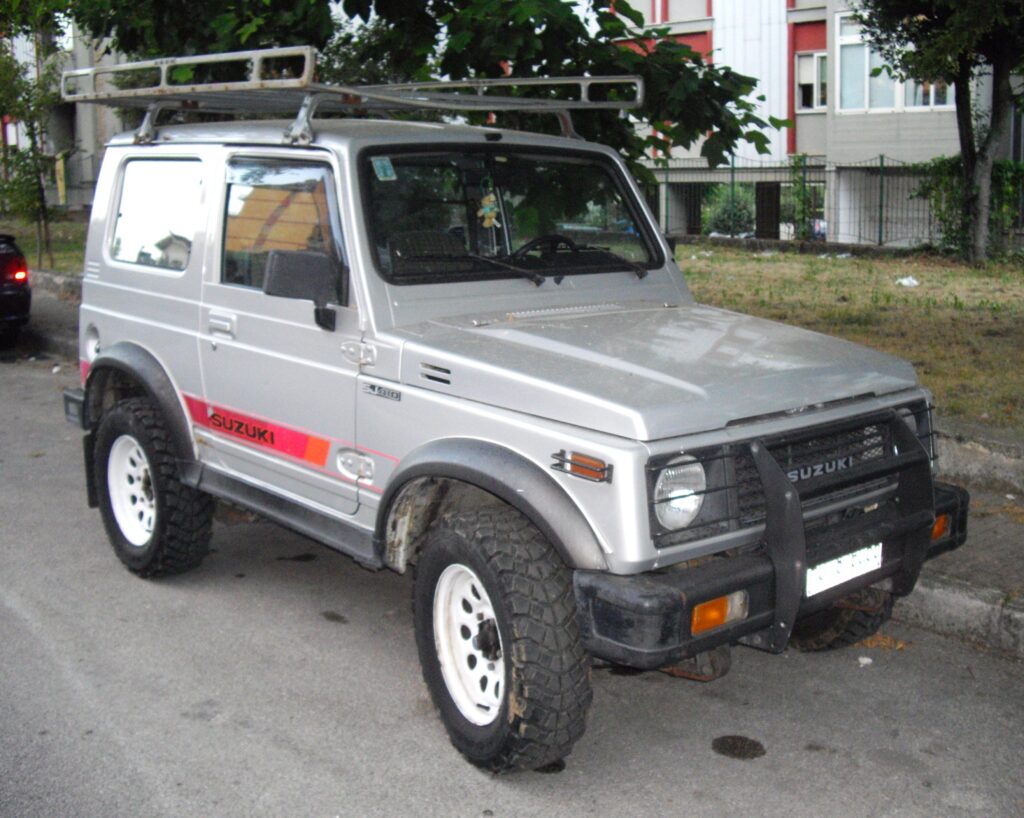
10. Suzuki Jimny: A Compact Off-Roader with Big Adventures in Mind
The Suzuki Jimny is a remarkable and iconic compact SUV that has captured the hearts of adventure enthusiasts and off-road aficionados since its inception in 1970. This rugged and compact 4×4 vehicle has maintained its off-road capabilities while evolving with modern features and technology.
Timeless Design with Off-Road DNA
One of the standout features of the Suzuki Jimny is its timeless and distinctive design. Its boxy, utilitarian shape pays homage to its off-road heritage, and it continues to attract admirers who appreciate its classic aesthetic. Despite its small size, the Jimny boasts a robust ladder frame construction and excellent approach and departure angles, making it a formidable off-road companion.
True Off-Road Prowess
The Suzuki Jimny is built for adventure. With a selectable four-wheel-drive system, low-range transfer case, and high ground clearance, it can conquer rugged terrain with ease. Whether you’re navigating through muddy trails, crossing rocky terrain, or fording shallow streams, the Jimny’s off-road prowess is hard to match in its class.
Compact and Practical
While the Suzuki Jimny excels off the beaten path, it’s also a practical choice for everyday use. Its compact size and manoeuvrability make it ideal for urban driving and parking in tight spaces. The interior offers seating for four passengers and a reasonable amount of cargo space, making it a versatile choice for both daily commuting and weekend adventures.
A Global Favorite
The Suzuki Jimny has garnered a dedicated fan base worldwide, and its reputation for reliability and durability has solidified its status as a global favourite among off-road enthusiasts. Whether you’re exploring the mountains, the beach, or the city streets, the Jimny is a reliable companion for your adventures.
Suzuki Jimny Statistics
| Specification | Detail |
| Production Years | 1970-Present |
| Engine | 1.5-liter inline-4 (varies by generation) |
| Power | Varies by generation, typically around 100 hp (74 kW) |
| Transmission | 5-speed manual / 4-speed automatic |
| Drive Type | Selectable four-wheel drive with low range |
| Dimensions (LxWxH) | Varies by generation, compact SUV size |
| Curb Weight | Approximately 1,100-1,300 kg |
| Unique Features | Off-road capabilities, rugged design, compact size |
The Suzuki Jimny is a testament to Suzuki’s commitment to providing a capable and compact off-road SUV that’s equally at home on city streets. Its enduring popularity and off-road prowess make it a vehicle that continues to inspire adventure seekers around the world.
Why Kei Cars Matter: Beyond the Compact Size
Kei cars are more than just small vehicles. They represent a unique aspect of Japanese automotive engineering, where constraints inspire creativity. This segment’s evolution mirrors broader shifts in technology, design, and consumer preferences. It’s a story of adaptation and ingenuity, reflecting the resilience and forward-thinking approach of Japan’s automobile industry.
The Cultural Significance of Kei Cars in Japan and Beyond
Japanese Kei cars are not just vehicles; they are cultural icons. These cars emerged in post-war Japan, a time when resources were scarce and space was at a premium. The Kei car segment blossomed as a solution to these challenges, offering affordable and practical transportation for the masses. Over the years, they have evolved, reflecting changes in technology, design trends, and consumer preferences.
Embodying Japanese Ingenuity and Efficiency
The design and engineering of Kei cars are a testament to Japanese innovation. In a country where space is limited, these cars offer a perfect blend of compactness and functionality. Their small footprint makes them ideal for navigating narrow streets and tight parking spaces, a common scenario in Japanese cities. Additionally, their fuel efficiency and lower emissions resonate with a global audience increasingly conscious about environmental sustainability.
A Global Influence
While primarily a Japanese phenomenon, Kei cars have influenced small car designs worldwide. Their principles of efficiency and compact design have inspired automakers globally, leading to the creation of city cars and microcars that cater to urban environments.
Final Thoughts
In a world where cars are often seen merely as tools, Kei cars remind us of the joy and creativity that can be found in automotive design. They encourage us to think differently about space, efficiency, and style. As we embrace the future of transportation, the lessons learned from the world of Kei cars will undoubtedly continue to influence and inspire.
| Aspect | Significance |
| Innovation | Reflects Japan’s ability to create practical, culturally significant solutions. |
| Global Influence | Influenced small car designs worldwide, offering insights into urban mobility. |
| Future Potential | Poised to evolve with electric vehicle technology and sustainable practices. |
| Enjoyment | Offers a unique blend of history, culture, and driving pleasure for enthusiasts and collectors. |
In closing, the story of Japanese Kei cars is one of resilience, innovation, and joy. These tiny yet mighty vehicles continue to captivate and inspire, proving that sometimes the best things indeed come in small packages.


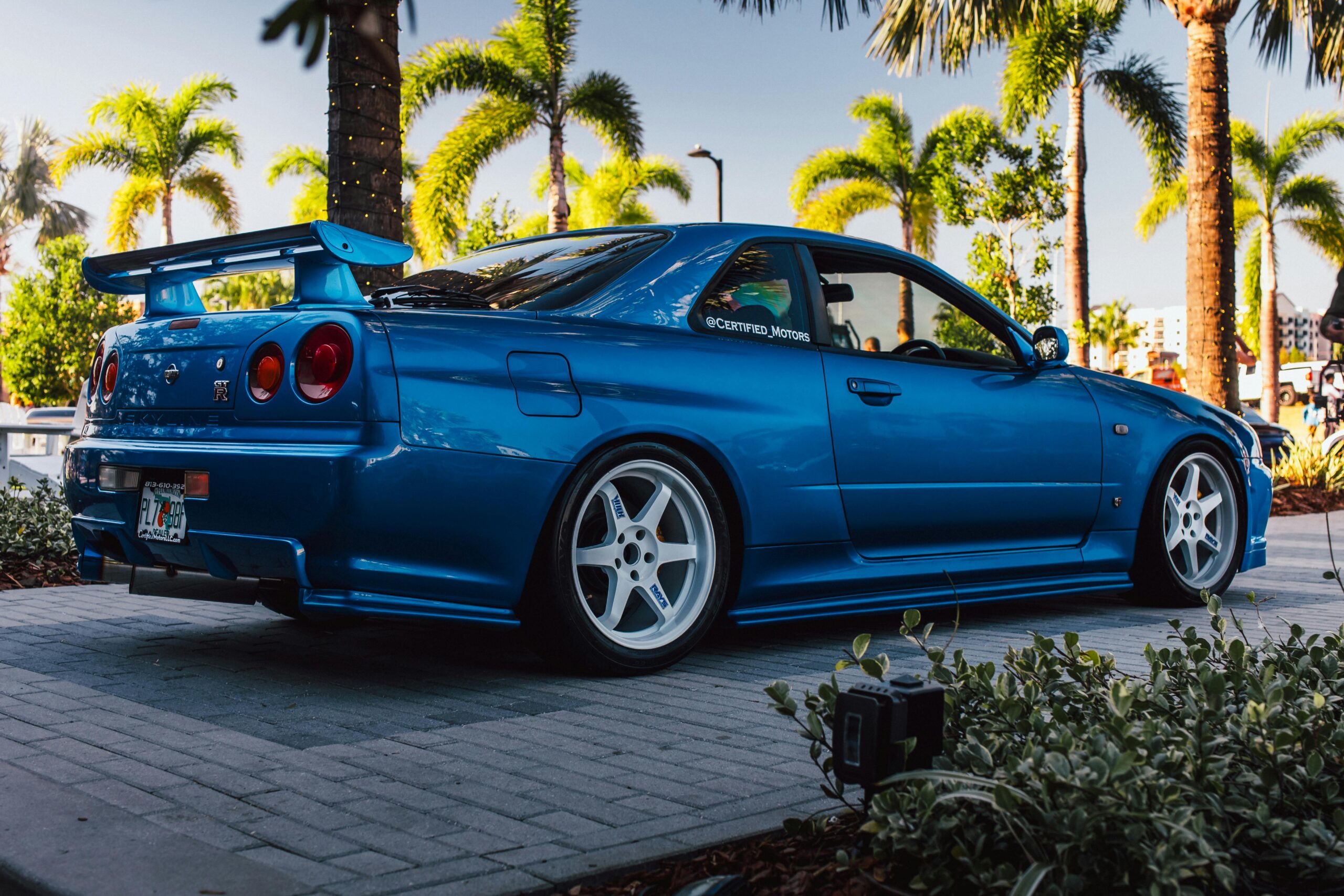
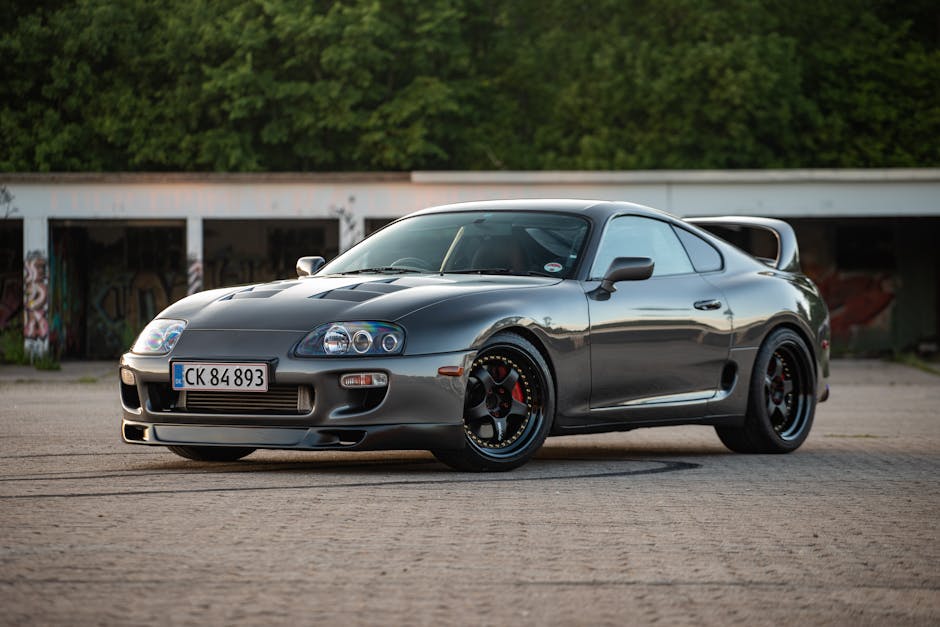
Add your first comment to this post